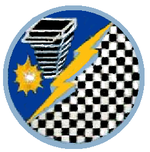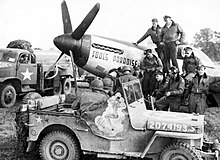16th Airborne Command and Control Squadron
 From Wikipedia - Reading time: 14 min
From Wikipedia - Reading time: 14 min
This article has multiple issues. Please help improve it or discuss these issues on the talk page. (Learn how and when to remove these messages)
|
| 16th Airborne Command and Control Squadron | |
|---|---|
 E-8C Joint STARS aircraft of the 461st Air Control Wing | |
| Active | 1943–1949; 1950–1989; 1996–2023 |
| Country | |
| Branch | |
| Role | Airborne Command and Control |
| Part of | Air Combat Command |
| Garrison/HQ | Robins Air Force Base, Georgia |
| Motto(s) | Light the Way |
| Engagements | European Theater of Operations Vietnam War Global War on Terrorism[1] |
| Decorations | Presidential Unit Citation Air Force Outstanding Unit Award with Combat "V" Device Air Force Meritorious Unit Award Air Force Outstanding Unit Award Belgian Fourragère Vietnamese Gallantry Cross with Palm[1] |
| Insignia | |
| 16th Airborne Command and Control Squadron emblem (approved 20 October 2016)[1] |  |
| 16th Airborne Command and Control Squadron emblem[2][note 1] |  |
| 16th Tactical Reconnaissance Squadron emblem (approved 31 July 1952)[3] |  |
The 16th Airborne Command and Control Squadron was a United States Air Force squadron assigned to Air Combat Command's 461st Air Control Wing, 461st Operations Group, stationed at Robins Air Force Base, Georgia. The squadron previously flew the Northrop Grumman E-8C JSTARS,[4] providing airborne battle management, command and control, surveillance, and target acquisition with the last E-8C flight on September 8, 2022.
Mission
[edit]The 16th Squadron operated the Northrop Grumman E-8C Joint STARS (Joint Surveillance Target Attack Radar System), an advanced ground surveillance and battle management system. J-STARS detected, located, classified, tracks and targets ground movements on the battlefield, communicating real-time information through secure data links with combat command posts.
History
[edit]World War II
[edit]The squadron was first activated as the 380th Fighter Squadron, part of IV Fighter Command in early 1943. It engaged in the air defense of the San Francisco area as well as acting as a Replacement Training Unit until the end of 1943. It trained as a North American P-51 Mustang operational squadron before deploying to the European Theater of Operations. In Europe it became part of IX Fighter Command in England. Operated both as a tactical fighter squadron, providing air support to Allied ground forces in France as well as an air defense squadron, attacking enemy aircraft in air-to-air combat over Europe.[1]

The squadron was converted to a tactical reconnaissance squadron in August 1944, when it was redesignated the 160th Tactical Reconnaissance Squadron. It engaged in hazardous reconnaissance flights over enemy-controlled territory unarmed, gathering intelligence for Allied commanders until the end of combat in Europe, May 1945. The unit advanced eastward across France using advanced landing grounds, then into the Low Countries and Occupied Germany.[1]
The squadron remained in Germany as part of the occupation forces, returning to Langley Field, Virginia in June 1947. The unit remained assigned to Tactical Air Command as a reconnaissance squadron. The squadron was inactivated in 1949.[1]
Cold War
[edit]In 1950 the squadron was activated once again at Langley, now designated the 16th Tactical Reconnaissance Squadron.[note 2] It moved to Shaw Air Force Base, South Carolina in 1958 where it re-equipped with McDonnell RF-101C Voodoo reconnaissance aircraft. The squadron deployed to south Florida in 1962 during the Cuban Missile Crisis, flying hazardous overflights over Cuba gathering intelligence photos.[5] The unit upgraded to the McDonnell Douglas RF-4C Phantom II in 1965. It also operated a flight of Martin EB-57E Canberra electronic warfare aircraft. It added Douglas EB-66 Destroyer jamming aircraft beginning in 1971 as part of the phaseout of the Destroyer at Shaw. It was the last USAF active duty B-57 squadron, retiring the aircraft in 1976 when F-4G Phantom IIs took over its mission.

The 16th remained the single RF-4C squadron at Shaw after the 1982 realignment of its parent 363d from a tactical reconnaissance to tactical fighter wing. It continued reconnaissance training in the United States until 1989 when the RF-4Cs were transferred to 67th Tactical Reconnaissance Wing at Bergstrom Air Force Base, Texas, and the squadron was inactivated.
Joint Surveillance Target Attack Radar System
[edit]The squadron was reactivated as the 16th Airborne Command and Control Squadron in 1996 at Robins Air Force Base, Georgia as an E-8 JSTARS squadron. In 2002, the JSTARS mission was transferred to the Georgia Air National Guard and the 116th Air Control Wing and the squadron became a Guard unit. Ten years later the mission returned to the regular Air Force, with Georgia Air National Guard associate units joining the mission.[1] As a JSTARS squadron, the 16th flew over 5,030 combat sorties, totalling 51,138 combat hours, and earned 9 Headquarters Air Force Battle Management Aircrew of the Year awards.[6] The squadron was inactivated on February 16, 2023.[7]
Lineage
[edit]- Constituted as the 380th Fighter Squadron (Single Engine) on 11 February 1943
- Activated in March 1943
- Redesignated 160th Tactical Reconnaissance Squadron on 25 August 1944
- Redesignated 160th Reconnaissance Squadron, Photographic on 29 Ju1y 1946
- Redesignated 160th Tactical Reconnaissance Squadron, Photographic on 14 June 1948
- Inactivated on 26 April 1949
- Redesignated 160th Tactical Reconnaissance Squadron, Night Photographic on 8 August 1950
- Activated on 1 September 1950
- Redesignated 16th Tactical Reconnaissance Squadron, Night Photographic on 10 October 1950
- Redesignated 16th Tactical Reconnaissance Squadron, Night Photographic-Jet on 8 November 1955
- Redesignated 16th Tactical Reconnaissance Squadron, Photographic-Jet on 1 March 1965
- Redesignated 16th Tactical Reconnaissance Squadron on 8 October 1966
- Redesignated 16th Tactical Reconnaissance Training Squadron on 1 October 1979
- Redesignated 16th Tactical Reconnaissance Squadron on 1 July 1982
- Inactivated on 15 December 1989
- Redesignated 16th Airborne Command and Control Squadron on 15 January 1996
- Activated on 1 October 1996
- Allotted to the Air National Guard on 1 October 2002
- Withdrawn from the Air National Guard on 1 October 2012 (remained active)[1]
- Inactivated on 16 February 2023[8]
Assignments
[edit]- 363d Fighter Group (later 363d Tactical Reconnaissance Group), 1 March 1943
- Air echelon attached to 10th Photographic Group, 24 December 1944 – 6 February 1945
- 10th Reconnaissance Group, 15 November 1945
- Tactical Air Command, 25 June 1947
- 363d Reconnaissance Group (later 363d Tactical Reconnaissance Group), 24 July 1947 – 26 April 1949
- 363d Tactical Reconnaissance Group, 1 September 1950
- 363d Tactical Reconnaissance Wing (later 363d Tactical Fighter) Wing), 8 February 1958 – 13 December 1989
- 93d Operations Group, 1 October 1996
- 116th Operations Group, 1 October 2002
- 461st Operations Group, 1 October 2012 – 16 February 2023 [1]
Stations
[edit]
|
|
Aircraft
[edit]- Bell P-39 Airacobra, 1943
- North American P-51 Mustang, 1944–1945, 1946–1947
- North American F-6 Mustang, 1944–1945, 1946–1947
- Lockheed FP-80 Shooting Star (later Lockheed RF-80 Shooting Star), 1947–1949
- Douglas RB-26 Invader, 1950–1955
- Martin RB-57 Canberra, 1954–1956
- Douglas RB-66 Destroyer, 1956–1965
- McDonnell RF-101C Voodoo, 1958–1965
- McDonnell RF-4C Phantom II, 1965–1989
- Martin EB-57E Canberra, 1971–1976
- Northrop Grumman E-8C Joint STARS (1996[1]–September 2022)[4]
References
[edit]Notes
[edit]- Explanatory notes
- ^ This emblem appears on the webpage of the 116th Air Control Wing, which was the squadron's headquarters while it was allotted to the Air National Guard. However, the Air Force Historical Research Agency indicates the 1952 emblem continues as the unit emblem, with a new rendition deleting the aerial camera and flash bomb being made in October 2016. Dollman.
- ^ The renumbering was required because the numbers 101–300 were reserved for Air National Guard units (now 101–299). AF Instruction 38-101, para. 5.3.4. When the squadron was allotted to the Air National Guard in 2002, it retained its number outside this block of numbers.
- ^ Aircraft is McDonnell RF-4C-34-MC Phantom II, serial 67-436. Note the NATO European camouflage schema, "SW" tail code and low visibility USAF markings. This was one of the last RF-4Cs flown by the 363d Wing before their retirement in 1989.
- Citations
- ^ a b c d e f g h i j Dollman, TSG David (7 August 2017). "Factsheet 16 Airborne Command and Control Squadron (ACC)". Air Force Historical Research Agency. Retrieved 27 April 2018.
- ^ "116th Air Control Wing: News: Art". 116th Air Control Wing Public Affairs. Retrieved 27 April 2018.
- ^ Maurer, Combat Squadrons, pp. 359–360
- ^ a b AirForces Monthly. Stamford, Lincolnshire, England: Key Publishing Ltd. November 2022. p. 20.
- ^ "16th AIRBORNE COMMAND AND CONTROL SQUADRON" (PDF). Retrieved 10 March 2020.
- ^ Speech by Lt Col Joseph Maruska, 16 ACCS commander, at inactivation ceremony, 16 Feb 2023.
- ^ a b AirForces Monthly. Stamford, Lincolnshire, England: Key Publishing Ltd. May 2023. p. 16.
- ^ "16th Airborne Command and Control Squadron flies final local sortie". Air Combat Command. Retrieved 20 February 2023.
- ^ a b c Station number in Anderson.
- ^ a b c d e f g h Station number in Johnson.
- ^ Station information in Dollman, except as noted.
Bibliography
[edit]![]() This article incorporates public domain material from the Air Force Historical Research Agency
This article incorporates public domain material from the Air Force Historical Research Agency
- Anderson, Capt. Barry (1985). Army Air Forces Stations: A Guide to the Stations Where U.S. Army Air Forces Personnel Served in the United Kingdom During World War II (PDF). Maxwell AFB, AL yes: Research Division, USAF Historical Research Center. Archived from the original (PDF) on 23 January 2016. Retrieved 28 June 2017.
- Johnson, 1st Lt. David C. (1988). U.S. Army Air Forces Continental Airfields (ETO) D-Day to V-E Day (PDF). Maxwell AFB, AL: Research Division, USAF Historical Research Center. Archived from the original (PDF) on 29 September 2015. Retrieved 26 June 2017.
{{cite book}}: CS1 maint: numeric names: authors list (link) - Maurer, Maurer, ed. (1983) [1961]. Air Force Combat Units of World War II (PDF) (reprint ed.). Washington, DC: Office of Air Force History. ISBN 0-912799-02-1. LCCN 61060979. Retrieved 17 December 2016.
- Maurer, Maurer, ed. (1982) [1969]. Combat Squadrons of the Air Force, World War II (PDF) (reprint ed.). Washington, DC: Office of Air Force History. ISBN 0-405-12194-6. LCCN 70605402. OCLC 72556. Retrieved 17 December 2016.
- Ravenstein, Charles A. (1984). Air Force Combat Wings, Lineage & Honors Histories 1947–1977. Washington, DC: Office of Air Force History. ISBN 0-912799-12-9. Retrieved 17 December 2016.
- Rogers, Brian. (2005). United States Air Force Unit Designations Since 1978. Hinkley, UK: Midland Publications. ISBN 1-85780-197-0.
- World Airpower Journal. (1992). US Air Force Air Power Directory. Aerospace Publishing: London, UK. ISBN 1-880588-01-3
- "Air Force instruction 38–101, Manpower and Organization: Air Force Organization" (PDF). Hq United States Air Force. 31 January 2017. Retrieved 28 April 2018.
 KSF
KSF


